

There was no Big Bang at the start of the universe, says physicist. "The observation of certain supernovas in the late 1990s led astronomers to the very unexpected discovery that the universe is expanding, and that the expansion is speeding up.
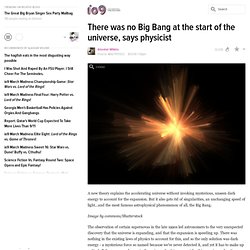
" Minor quibble on how this is worded. We've known the universe was expanding since the 1920s when Hubble and Humason proved it by measuring the red shift of galaxies against the known brightness of cepheid variable stars. However our discovery that the universe is not only expanding but actually accelating is something we didn't know until the 90s and that is more or less as you have it.
Anyway, yes, I read about this a few weeks ago. "The Big Bang was a Mirage from a Collapsing Higher-Dimensional Star" Big Bang was a mirage from collapsing higher-dimensional star, theorists propose.
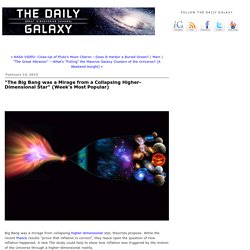
While the recent Planck results “prove that inflation is correct”, they leave open the question of how inflation happened. A new The study could help to show how inflation was triggered by the motion of the Universe through a higher-dimensional reality. The event horizon of a black hole — the point of no return for anything that falls in — is a spherical surface. In a higher-dimensional universe, a black hole could have a three-dimensional event horizon, which could spawn a whole new universe as it forms.
It could be time to bid the Big Bang bye-bye. Big Bang theory could be debunked by Large Hadron Collider. The huge amounts of energy needed to make ‘rainbow gravity’ would mean that the early universe was very different.
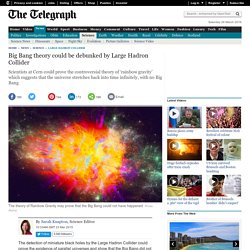
One result would be that if you retrace time backward, the universe gets denser, approaching an infinite density but never quite reaching it. The effect of rainbow gravity is small for objects like the Earth but it is significant and measurable for black holes. It could be detected by the Large Hadron Collider if it picks up or creates black holes within the accelerator.
“We have calculated the energy at which we expect to detect these mini black holes in gravity's rainbow [a new theory]. If we do detect mini black holes at this energy, then we will know that both gravity's rainbow and extra dimensions are correct, Dr Mir Faizal told Phys.org. Roger Penrose - Cyclic Universe Model. 'A Universe From Nothing' by Lawrence Krauss, AAI 2009. Physicists May Have Evidence Universe Is A Computer Simulation. Physicists say they may have evidence that the universe is a computer simulation.
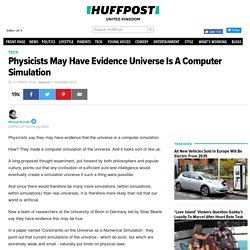
How? They made a computer simulation of the universe. And it looks sort of like us. A long-proposed thought experiment, put forward by both philosophers and popular culture, points out that any civilisation of sufficient size and intelligence would eventually create a simulation universe if such a thing were possible. And since there would therefore be many more simulations (within simulations, within simulations) than real universes, it is therefore more likely than not that our world is artificial. The Measurement That Would Reveal The Universe As A Computer Simulation. One of modern physics’ most cherished ideas is quantum chromodynamics, the theory that describes the strong nuclear force, how it binds quarks and gluons into protons and neutrons, how these form nuclei that themselves interact.
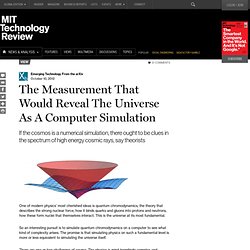
This is the universe at its most fundamental. So an interesting pursuit is to simulate quantum chromodynamics on a computer to see what kind of complexity arises. The promise is that simulating physics on such a fundamental level is more or less equivalent to simulating the universe itself. There are one or two challenges of course. The physics is mind-bogglingly complex and operates on a vanishingly small scale. That may not sound like much but the significant point is that the simulation is essentially indistinguishable from the real thing (at least as far as we understand it).
It’s not hard to imagine that Moore’s Law-type progress will allow physicists to simulate significantly larger regions of space. First, some background. What they find is interesting. Neutrino Experiment Intensifies Effort to Explain Matter-Antimatter Asymmetry. It felt like the Apollo control room seconds before the moon landing.
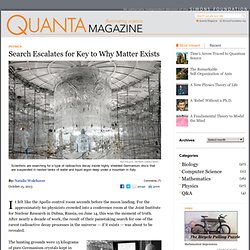
For the approximately 60 physicists crowded into a conference room at the Joint Institute for Nuclear Research in Dubna, Russia, on June 14, this was the moment of truth. After nearly a decade of work, the result of their painstaking search for one of the rarest radioactive decay processes in the universe — if it exists — was about to be revealed. Courtesy of Allen Caldwell Members of the GERDA Collaboration met in Dubna, Russia, this summer for the much-anticipated unveiling of their experimental results.
The hunting grounds were 15 kilograms of pure Germanium crystals kept in extreme isolation deep under a mountain in Italy. Among the bedlam of electrical activity caused by other types of decays, detector noise and rogue radiation, the physicists expected their instruments to pick up two or three spikes of background noise closely resembling the spikes from neutrino-less double beta decay. The Multiverse’s ‘Measure Problem’ If modern physics is to be believed, we shouldn’t be here.
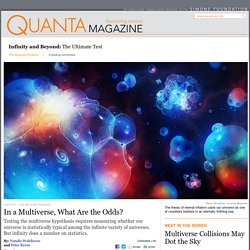
The meager dose of energy infusing empty space, which at higher levels would rip the cosmos apart, is a trillion trillion trillion trillion trillion trillion trillion trillion trillion trillion times tinier than theory predicts. And the minuscule mass of the Higgs boson, whose relative smallness allows big structures such as galaxies and humans to form, falls roughly 100 quadrillion times short of expectations. Dialing up either of these constants even a little would render the universe unlivable. To account for our incredible luck, leading cosmologists like Alan Guth and Stephen Hawking envision our universe as one of countless bubbles in an eternally frothing sea. This infinite “multiverse” would contain universes with constants tuned to any and all possible values, including some outliers, like ours, that have just the right properties to support life.